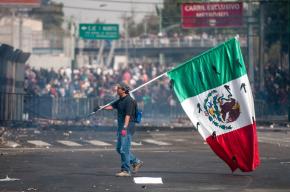Protesting the return of the PRI
reports on a day of pitched battles between police and protesters as the candidate of Mexico's longtime ruling party took back the presidency.
IF YOU watched the swearing-in of the Mexico's newly (and fraudulently) elected President Enrique Peña Nieto on television, you might have thought that the event was cause for joyous celebration. That was the aim of the carefully stage-managed proceedings, which were designed to hide the widespread protests in Mexico City and other major urban centers like Guadalajara that challenged Peña Nieto's inauguration.
The student movement #YoSoy132, which got its start last May, charged the government with rigging the election in favor of the Institutional Revolutionary Party (known by its Spanish acronym PRI) and its candidate Peña Nieto. AS SocialistWorker.org's Lance Selfa explained:
#YoSoy132 exploded onto the national scene in May, when students at Ibero-American University protested Peña Nieto's appearance there, forcing him to flee the stage. The student protest mushroomed like the U.S. Occupy movement and Greece's "movement of the squares," with mass student demonstrations focused on democratization of the country, its institutions and media.
Erupting only a few weeks before the national elections, the student movement disrupted the ruling class's plans to assure an easy transition from the right-wing PAN, which presided over 12 years of neoliberal "reform," to an equally business-friendly PRI.

#YoSoy132 has done all it can to keep the PRI, which ruled Mexico as a one-party state from 1929 to 2000, from burying the memory of its long history of repression--from the Tlatelolco massacre of the 1968 student movement to its suppression of the 1994 Zapatista uprising.
Though Peña Nieto desperately wants to present himself as the new face of a newly reinvented party, he is himself a living embodiment of the PRI's ugly history. As governor of the state of Mexico, he ordered state police to repress a mobilization of flower vendors, which resulted in two deaths, the sexual assault of dozens of women, and the arrest and brutal beatings of hundreds.
FOR WEEKS, activists planned protests for the December 1 inauguration. When the day finally arrived, hundreds of protesters gathered at 3 a.m. in Mexico City's Monumento a la Revolución and from there marched to the San Lázaro Legislative Palace where Peña Nieto would later take the oath of office.
The streets near the legislative chambers were lined with steel barriers 10 feet high--and hundreds of police on the other side. Determined to get to the other side, protesters vented their anger at the fence, throwing rocks at it and shaking it. When they managed to create an opening, the police responded by shooting tear gas directly into the crowd.
For the rest of the day, repeated confrontations between police and protesters--what is now being referred to as the "Battle of San Lázaro"--broke out in the streets around the legislature. While police used all their expensive weaponry, protesters fought back with sticks, rocks and the occasional Molotov cocktail.
Later, protesters made their way to historic Bella Artes district of Mexico City, where the confrontation with police became more direct. Protesters made makeshift barricades and fought the police bravely, but were overpowered and chased out by the repressive state apparatus in full riot gear.
When the tumultuous day came to an end, two protesters had been seriously injured (one suffered a direct hit to the head from a tear-gas canister), 70 people were arrested (including members of the media) and many more were wounded. There was also thousands of dollars in property damage, both from the street battles and from small bands of protesters who smashed bank and hotel windows.
But what the battle ultimately revealed is that the new PRI government is not very different from the old PRI governments. Activists called for another mobilization the next day to call for Peña Nieto to step down as president and for the release of all political prisoners.
Freeing those arrested in the December 1 protests has become a central demand of the movement, and rightfully so, given the PRI's record of holding social-justice activists captive. In fact, since 1968 more than 500 activists have become desaparecidos (disappeared) in Mexico. A popular slogan is "Vivos se los llevaron, vivos los queremos" (You took them alive, and that's how we want them back).
The movement is seeking to make the PRI's repression an international issue and publicizing its demands abroad by launching a picture solidarity campaign via Facebook so those outside Mexico can show their support.
Though the student movement wasn't able to stop the imposition of Peña Nieto as president of Mexico, it is determined to see that democracy becomes reality in Mexico. This includes free and fair elections as well as the right to protest. In the language of the Mexico's student movement, "si uno es preso, todos somos presos" ("When one of us is a prisoner, we are all prisoners").


